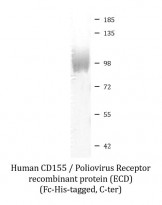ARG70296
Human CD155 / Poliovirus Receptor recombinant protein (ECD) (Fc-His-tagged, C-ter)
Human CD155 / Poliovirus Receptor recombinant protein (ECD) (Fc-His-tagged, C-ter) for Binding Activity,SDS-PAGE and Human
Overview
| Product Description | HEK293 expressed, Fc-His-tagged (C-ter) Human CD155 / Poliovirus Receptor recombinant protein (ECD). |
|---|---|
| Tested Reactivity | Hu |
| Tested Application | Binding, SDS-PAGE |
| Target Name | CD155 / Poliovirus Receptor (ECD) |
| Species | Human |
| A.A. Sequence | Asp28 - Asn343 of Human CD155 / Poliovirus Receptor (NP_006496.4) with an Fc-6X His tag at the C-terminus. |
| Expression System | HEK293 |
| Alternate Names | NECL5; CD antigen CD155; Nectin-like protein 5; PVS; Necl-5; HVED; Poliovirus receptor; TAGE4; NECL-5; CD155 |
Application Instructions
| Application Note | Binding activity test: Measured by its binding ability in a functional ELISA. Immobilized Recombinant Human TIGIT at 2 µg/ml (100 µl/well) can bind Recombinant Human CD155 with a linear range of 0.3-1 µg/ml. |
|---|
Properties
| Form | Powder |
|---|---|
| Purification Note | 0.22 µm filter sterilized. Endotoxin level is <0.1 EU/µg of the protein, as determined by the LAL test. |
| Purity | >97% (by SDS-PAGE) |
| Buffer | PBS (pH 7.4) |
| Reconstitution | Reconstitute to a concentration of 0.1 - 0.5 mg/ml in sterile distilled water. |
| Storage Instruction | For long term, lyophilized protein should be stored at -20°C or -80°C. After reconstitution, aliquot and store at -20°C for up to one month, at 2-8°C for up to one week. Storage in frost free freezers is not recommended. Avoid repeated freeze/thaw cycles. Suggest spin the vial prior to opening. |
| Note | For laboratory research only, not for drug, diagnostic or other use. |
Bioinformation
| Gene Symbol | PVR |
|---|---|
| Gene Full Name | poliovirus receptor |
| Background | The protein encoded by this gene is a transmembrane glycoprotein belonging to the immunoglobulin superfamily. The external domain mediates cell attachment to the extracellular matrix molecule vitronectin, while its intracellular domain interacts with the dynein light chain Tctex-1/DYNLT1. The gene is specific to the primate lineage, and serves as a cellular receptor for poliovirus in the first step of poliovirus replication. Multiple transcript variants encoding different isoforms have been found for this gene. [provided by RefSeq, Oct 2008] |
| Function | Mediates NK cell adhesion and triggers NK cell effector functions. Binds two different NK cell receptors: CD96 and CD226. These interactions accumulates at the cell-cell contact site, leading to the formation of a mature immunological synapse between NK cell and target cell. This may trigger adhesion and secretion of lytic granules and IFN-gamma and activate cytoxicity of activated NK cells. May also promote NK cell-target cell modular exchange, and PVR transfer to the NK cell. This transfer is more important in some tumor cells expressing a lot of PVR, and may trigger fratricide NK cell activation, providing tumors with a mechanism of immunoevasion. Plays a role in mediating tumor cell invasion and migration. (Microbial infection) Acts as a receptor for poliovirus. May play a role in axonal transport of poliovirus, by targeting virion-PVR-containing endocytic vesicles to the microtubular network through interaction with DYNLT1. This interaction would drive the virus-containing vesicle to the axonal retrograde transport. (Microbial infection) Acts as a receptor for Pseudorabies virus. (Microbial infection) Is prevented to reach cell surface upon infection by Human cytomegalovirus /HHV-5, presumably to escape immune recognition of infected cell by NK cells. [UniProt] |
| Cellular Localization | Isoform Alpha: Cell membrane; Single-pass type I membrane protein. Isoform Delta: Cell membrane; Single-pass type I membrane protein. Isoform Beta: Secreted. Isoform Gamma: Secreted. [UniProt] |
| Calculated MW | 45 kDa |
| PTM | N-glycosylated. N-glycan at Asn-120: Hex5HexNAc4. Phosphorylated by Src kinases on tyrosine residues in the ITIM motif upon ligation. Interaction with TIGIT is required for Phosphorylation. [UniProt] |
Images (1) Click the Picture to Zoom In






